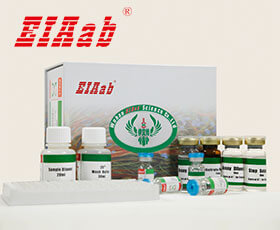Camsap3 (基因名), Calmodulin-regulated spectrin-associated protein 3 (蛋白名), camp3_mouse.
产品名称:
Mouse Camsap3/ Calmodulin-regulated spectrin-associated protein 3 Recombinant Protein
货号:
-
商标:
EIAab®
监管等级:
别名:
Marshalin, Protein Nezha, Kiaa1543
序列号:
Q80VC9
来源:
E.coli
种属:
Mouse
标签:
His
纯度:
>90% by SDS-PAGE
浓度:
Reconstitution Dependent
形态:
Liquid
内毒素水平:
Please contact protein@eiaab.com The technician for more information.
应用:
存储缓冲液:
50mM NaH2PO4, 500mM NaCl Buffer with 500mM Imidazole, 10%glycerol(PH8.0)
存储:
Store at -20°C. (Avoid repeated freezing and thawing.)
研究领域:
-
通用注释
亚单元:
Interacts with PLEKHA7 (By similarity). Interacts with CAMSAP2 (PubMed:23169647). Interacts with KATNA1 and KATNB1; leading to regulate the length of CAMSAP3-decorated microtubule stretches (By similarity). Interacts with AKAP9; regulating Golgi assembly in epithelial cells (By similarity). Interacts with MACF1 (By similarity). Interacts with isoform C of CDH23; leading to inhibit CAMSAP3 ability to induce microtubule bundle formation (PubMed:27349180). Interacts with AKNA (PubMed:30787442).
功能:
Key microtubule-organizing protein that specifically binds the minus-end of non-centrosomal microtubules and regulates their dynamics and organization (PubMed:23169647, PubMed:24706919, PubMed:26715742). Specifically recognizes growing microtubule minus-ends and autonomously decorates and stabilizes microtubule lattice formed by microtubule minus-end polymerization (PubMed:24706919). Acts on free microtubule minus-ends that are not capped by microtubule-nucleating proteins or other factors and protects microtubule minus-ends from depolymerization (PubMed:24706919). In addition, it also reduces the velocity of microtubule polymerization (PubMed:24706919). Required for the biogenesis and the maintenance of zonula adherens by anchoring the minus-end of microtubules to zonula adherens and by recruiting the kinesin KIFC3 to those junctional sites (By similarity). Required for orienting the apical-to-basal polarity of microtubules in epithelial cells: acts by tethering non-centrosomal microtubules to the apical cortex, leading to their longitudinal orientation (PubMed:26715742). Plays a key role in early embryos, which lack centrosomes: accumulates at the microtubule bridges that connect pairs of cells and enables the formation of a non-centrosomal microtubule-organizing center that directs intracellular transport in the early embryo (PubMed:28860385). Couples non-centrosomal microtubules with actin: interaction with MACF1 at the minus ends of non-centrosomal microtubules, tethers the microtubules to actin filaments, regulating focal adhesion size and cell migration (By similarity). Plays a key role in the generation of non-centrosomal microtubules by accumulating in the pericentrosomal region and cooperating with KATNA1 to release non-centrosomal microtubules from the centrosome (By similarity). Through the microtubule cytoskeleton, also regulates the organization of cellular organelles including the Golgi and the early endosomes (By similarity). Through the microtubule cytoskeleton, also regulates the organization of cellular organelles including the Golgi and the early endosomes (By similarity). Through interaction with AKAP9, involved in translocation of Golgi vesicles in epithelial cells, where microtubules are mainly non-centrosomal (By similarity).
亚细胞位置:
Cytoplasm
Cytoskeleton
Cell junction
Adherens junction
Cytoplasm
Scattered in the cytoplasm, associated with the minus-end of microtubules and also detected at the centrosomes (PubMed:24706919, PubMed:26715742). Decorates the minus-end of microtubules by decreasing the rate of tubulin incorporation and remaining bound (By similarity). Localizes along zonula adherens only at mature cell-cell contacts (By similarity). In early embryos, accumulates at the microtubule bridges that connect pairs of cells: this structure is present in early embryos, which lack centrosomes (PubMed:28860385). This cytokinetic bridge does not undergo stereotypical abscission after cell division (PubMed:28860385). Accumulates to the pericentrosomal region following interaction with KATNA1 (By similarity).
数据库链接
您可能感兴趣
该产品尚未在任何出版物中被引用。
[1].
小鼠Camsap3重组蛋白是否是无菌的?
蛋白试剂瓶和蛋白保存液是经过高压灭菌的,但也不能保证蛋白是完全无菌的。如果要求蛋白是无菌的,可以用0.2微米的滤器对蛋白进行过滤。
[2].
小鼠Camsap3重组蛋白的保存缓冲液是什么?
纯化后的蛋白保存在PBS(58mM Na2HPO4, 17mM NaH2PO4, 68mM NaCl, pH7.4)里,并往里面加入500mM咪唑和10%甘油。
[3].
怎样确定小鼠Camsap3重组蛋白的浓度?
蛋白浓度的确定没有一个统一的标准,这主要取决于蛋白的氨基酸序列。伊艾博是根据不同测试的组合来测定蛋白浓度。考马斯亮蓝法、BCA法、氨基酸序列和氨基酸全序列分析法等都用来测定蛋白浓度。
[4].
小鼠Camsap3重组蛋白蛋白保存条件是怎样的?
蛋白应保存在 -20℃或 -80℃条件下,为了避免反复冻融,可以将蛋白分装成小份保存。
[5].
小鼠Camsap3重组蛋白是否可以用于活体实验?
重组蛋白没有用于任何的活体实验,因此蛋白的活性和半衰期是不确定的。
[6].
小鼠Camsap3重组蛋白的保质期是多久?
在适当的保存条件下,从购买之日起蛋白可以稳定保存6-12个月。适当的保存条件是:蛋白保存在-20°C o或 -80℃,保证蛋白的保存浓度高于0.1mg/ml,限制蛋白反复冻融的次数。我们公司常规的质量检测保证所有产品在销售时都有可接受的生物活性。但是我们不能控制终端用户蛋白的保存条件。如果产品在有效期内出现问题,请联系我们的技术支持。
[7].
你们蛋白和抗体的报价是怎么样的?
我们将根据你需要的蛋白和抗体的大小进行报价。
[8].
小鼠Camsap3重组蛋白是否能够提供蛋白片段?
我们现有的人的蛋白的序列可以有很多。你可以选择你感兴趣的靶向部分,我们将会按您的需求提供蛋白和抗体。
[9].
小鼠Camsap3重组蛋白的货期或发货时间一般是多长?
具体指标的货期需要确定。最快一周,最长可能一个月。
反馈墙
评论数 : 0
所有用户
所有用户
默认排序
默认排序
最近
早期
目前还没有评论。






通知
规格
数量
单价 (¥)
小计 1 (¥)
小计 2:
¥

规格
数量
单价 (¥)





 验证序列:
验证序列:




 折扣:
折扣: